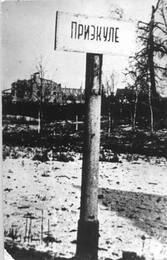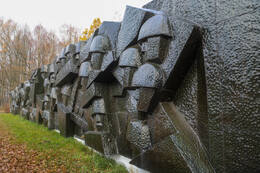19-mečio Alfonso Wolgemutho pasakojimas apie žvalgybos mūšį 1945 m. vasario 17 d. netoli Priekulės
Alfonsas Volgemuthas buvo 19 metų berniukas, radijo operatorius ir tarnavo nacistinės Vokietijos armijoje.
„Iš šios operacijos niekas negrįžo ir nežinoma, ar yra išgyvenusiųjų. Aš pats dalyvavau tame kare kaip 19 metų radijo operatorius ir esu vienas iš 2, vėliau 3 išgyvenusiųjų, kuriuos rusai paėmė į nelaisvę. Noriu prisiminti įvykius iš savo patirties.“
Vasario 16 d. buvome miško pakraštyje į šiaurę nuo Priekulės. Gavome įsakymą būti pasiruošusiems mūšiui 22 val. buvusiame Priekulės dvare. Patikrinome radiją ir vakare nuvykome į nurodytą vietą, kur jau buvo susirinkę apie 200 grenadierių iš II/GR426 ir 20 tankų.
Mes tyliai kalbėjomės. Supratome, kad stosime į mūšį su tankais. Mudu su Franci atsisėdome ant žemės prie didelio medžio. Buvo stingdančiai šalta, bet ne per šalta. Laukdami įsakymo išvykti, kalbėjomės apie tai, kas mūsų gali laukti.
Iki šiol artilerijos ugnį valdėme radijo ryšiu, bet dabar atrodė, kad teks dalyvauti mūšyje. Francis liepė man visą laiką likti su juo. Ir tada pradėjo riaumoti tankai, kiekvienas iš jų pasiėmė apie 10 vyrų, kurie susėdo ant platformos. Mes trise sėdėjome ant priekinio tanko, už kurio visi kiti judėjo į pietvakarius. Buvo apie 2 val. nakties 1945 m. vasario 17 d. Judėjome per geležinkelį, mišku, keliu pietvakarių kryptimi. Ugnis nebuvo labai intensyvi. Iš pradžių rusai šaudė tik iš šaulių ginklų, vėliau iš prieštankinių pabūklų. Likome nenukentėję, tik granatos skeveldra nuplėšė Francis bato kulną.
Kai nuvažiavome apie 3–4 km, tankai sustojo. Nušokome nuo jų. Kulkos skraidė aplinkui. Šūviai aidėjo nuo kalvos, esančios maždaug už 100 m kairėje kelio pusėje, nuo kažkokių sodybų. Palei kelią ėjo nelabai gilus griovys, įšokome į jį. Tankai apsisuko ir nuvažiavo. Tamsoje matėme nedidelį tvartą, iš kurio išbėgo 2 rusų kareiviai. Akivaizdu, kad be ginklų. Vienas iš jų atrodė sužeistas.
Francis sušuko: „Stok! Rankas aukštyn!“ Abu kareiviai pakėlė rankas į orą. Pasidavė. Nubėgome į tvartą. Tai tikriausiai buvo mūsų tikslas, kur vadas įsakė mums užimti kovos pozicijas. Netrukus prieš šią akimirką teritorija buvo visiškai vokiečių rankose. Tvartas, maždaug 6x6 m dydžio. Apačioje buvo rūsys su giliu įėjimu, kuriame buvo trys lentomis atskirtos kameros. Pirmajame, didžiausiame, stovėjo didelis stalas su telefonais. Tolimajame skyriuje, kuriame buvo dviejų aukštų undinės, įkalinome du rusų kalinius. Sutvarkėme siųstuvus ir antenas.
Bandėme susisiekti su savo baterija, bet negavome jokio atsakymo. Vėliau irgi nepavyko užmegzti ryšio. Lauke girdėjosi triukšmas. Mūsų vyrai puolė ten esančias rusų pozicijas. Išsiuntėme pranešimą apie situaciją, bet atsakymo negavome. Grenadieriai užėmė rusų pozicijas, tik patyrę labai didelių nuostolių. Sanitarai atvežė į mūsų rūsį 2 sužeistuosius ir jais pasirūpino.
Vieno iš atokvėpio metu išleidau sužeistą rusą iš nuovados. Jam buvo šautinė žaizda krūtinėje, bet jis kvėpavo puikiai. Aprišau jį, daviau jiems abiem po gabalėlį duonos ir cigaretę.
Auštant medikai ištraukė dar vieną sužeistą vyrą. Jis gulėjo maždaug už 100 m nuo mūsų, sunkiai dejuodamas. Kurį laiką niekas nešaudė. Tada kovos atsinaujino. Atrodė, kad rusai gavo pastiprinimą ir vėl puola.
Rusai pradėjo naudoti sunkiuosius ginklus. Mus pasiekė keli granatsvaidžiai ir pareiškė, kad nebegali išlaikyti šios pozicijos, nes dauguma mūsų, kareivių ir karininkų, jau buvome kritę. Nieko kito neliko, kaip tik trauktis. Rūsyje buvo 14 kareivių ir trys sužeisti. Karininkų nebuvo. Vienas iš kareivių pasiūlė bėgti per maždaug 250 m pločio atvirą lauką iki miško pakraščio. Tai būtų buvę įmanoma, jei būtume turėję priešgaisrinę apsaugą. Todėl buvo nuspręsta: trys iš mūsų liksime ir nuolat šaudysime į rusus, kad likusieji turėtų galimybę atsitraukti į netoliese esantį mišką.
Kad pasiliktume rūsyje ir padėtume jiems slėptis nuo ugnies, jie pasirinko mane, dar vieną devyniolikmetį vaikiną ir vyresnį grenadierių su galvos žaizda. Vasario 17-osios rytą, apie 10 val., kiti paliko sodybos rūsį. Mes trys kiek įmanydami apšaudėme rusų pozicijas. Kiti bėgo tuo pačiu būdu – kiek įmanydami. Vienas iš bėgikų parkrito ir liko gulėti. Manau, tai buvo medikas. Kiti pasiekė miško pakraštį, bet ten juos pasitiko rusų ugnis. Išgirdau garsius riksmus. Man pasirodė, kad tarp jų girdėjau savo draugo Franzo Kellenterio balsą. Tada viskas nutilo. Mus taip pat apgaubė tyla. Siaubinga tyla.
Supratome, kad būsime sugauti arba sušaudyti. Sužeistieji tyliai dejavo. Jų likimas taip pat nebuvo žinomas. Durys į lauką liko atviros. Nežinojau, ar išeiti, ar pasilikti čia – rūsyje.
Staiga kelyje pasirodė vokiečių tankas. Jis sustojo. Jis nešaudė ir į jį nebuvo šaudoma. Todėl nusprendėme, kad tai rusų tankas. Tada jis staigiai pasisuko ir nuvažiavo. Po kelių minučių lauke išgirdau tylų garsą, tarsi kažkas atsargiai vaikščiotų griuvėsiais. Pažvelgiau į atviras rūsio duris ir pamačiau barzdotą veidą tiriančiomis akimis. Tada tos akys pamatė mane! Vyras staigiai pasisuko ir dingo. Po kelių minučių lauke išgirdome garsius balsus. Rankinė granata nukrito prie rūsio įėjimo ir garsiai sprogo. Dalis skeveldrų pataikė į sužeistuosius, ir jie garsiai rėkė.
Na, mūsų rusų belaisviai irgi kažką šaukė savo bendražygiams. Mes juos paleidome. Po kurio laiko ir mus pašaukė išeiti pakeltomis rankomis. Priešais mus stovėjo sovietų armijos seržantas su pistoletu rankoje ir dar keli rusų kareiviai. Sužeistieji rūsyje dejavo ir rėkė. Seržantas nukrito. Išgirdome šūvius. Tada viskas nutilo.
Seržantas priėjo prie manęs ir nusitaikė. Tada abu mūsų kaliniai pradėjo kalbėti, rodydami į mus. Seržantas nuleido ginklą. Mūsų kišenės buvo apieškotos. Mano rožių vainikas buvo numestas ant žemės. Priėjo daugiau rusų kareivių. Mus nuvedė į tvarstymo punktą. Pakeliui turėjome nešti neštuvus su sunkiai sužeistu kareiviu. Jam buvo nuplėšta koja. Ją laikė tik mažas audinio gabalėlis. Nešant jį per lauką, netoliese prasidėjo šaudymas. Kaip įprasta, kritome ant žemės. Sužeistas rusas ant neštuvų skausmo klykė. Jis vis kartojo: „Tichonko, tichonko!“ Tada nežinojau, ką tai reiškia. Vėliau, kai šiek tiek išmokau rusų kalbos, supratau, ką reiškia šis žodis.
Taigi, pasiekėme rusų štabą kaimo name. Ten mus apklausė po vieną. Grasindami pakarti (rodydami virvę), gavau įsakymą žemėlapyje parodyti mūsų baterijos pozicijas. Tai buvo rusiškas žemėlapis. Pasakiau, kad jame nieko negaliu įskaityti. Tada man atnešė vokišką žemėlapį. Ten pamačiau kelią, kuriuo važiavome iš Paplako į Priekulę. Pirštu parodžiau į žemėlapį ir parodžiau į lauką, esantį apie 200 m į kairę nuo kelio. Iš tikrųjų mūsų pozicijos buvo dešinėje kelio pusėje, už miško.
Vėliau, po kapituliacijos, karo belaisvių stovykloje sutikau mūsų dalinio seržantą majorą. Jis buvo maloniai nustebintas mane sutikęs. Jis papasakojo, kad vasario 17 d. niekas negrįžo iš mūsų operacijos ir kad tą dieną netoli mūsų pozicijų, kairėje kelio pusėje, buvo intensyviai apšaudoma. Tačiau mūsų kariai didelių nuostolių nepatyrė.
Trečiasis iš mūsų, vyresnysis grenadierius su galvos žaizda, buvo visiškai dezorientuotas. Matyt, paveiktas savo bendražygių mirties. Rusas nuėjo su juo už tvarto. Iš ten nuėjo šūvis, ir rusas grįžo. Vienas. Taigi likome vieni. Vakare mane nuvedė pas du aukštesnio rango rusų karininkus. Vienas iš jų kalbėjo vokiškai. Jis kalbėjosi su manimi labai žmogiškai. Beje, jis paklausė apie mano požiūrį į karą. Papasakojau jam apie savo gyvenimą ir kaip nacių vyriausybė elgėsi su mano šeima. Mano tėvas buvo policininkas;
Jis buvo atleistas iš darbo 1934 m. už tai, kad atsisakė stoti į SS. Jo tėvas žuvo Prancūzijoje 1944 m. Po tardymo mums davė sorų košės, duonos ir vandens.
Naktį praleidome kartu su keliais rusų kareiviais viename kambaryje. Mums buvo leista miegoti po lovomis ant grindų. Kitą dieną, lydimi kelių kareivių, sunkvežimiu buvome nuvežti į kalinių surinkimo punktą, esantį angare Škodos rajone. Ten mūsų buvo apie 10. Tarp jų nebuvo nė vieno iš mūsų kovinės grupės nario. Tikriausiai ir daugiau kalinių nebuvo. Mūsų operacijoje dalyvavo apie 200 vyrų. Jei čia nieko nebuvo, tik mes abu, vadinasi, visi turėjome kristi. Šios operacijos prasmė ir tikslas aprašyti divizijos kronikoje. Strategija ir vykdymas man, kaip strategijos mėgėjui, nesuprantami. Taip pat nesuprantu, už ką buvo sumokėta 200 gyvybių.
Po to dveji metai buvo rusų nelaisvėje Rygoje: stovykla Kaizervalde, darbai valant griuvėsius mieste ir Olaine – durpių stovykloje į pietus nuo Rygos uosto. Durpių darbai tęsėsi visą vasarą. Mūsų posakis: „Vanduo iš viršaus (lietus), vanduo iš apačios (pelkė), vanduo viduje (kojose iš bado) – ta Olaine kenčia.“ Iki rudens jau buvau numetęs 50 kg. Tada buvau perkeltas į Šiaurės Estiją: Kotla-Järve, Jove, Tammiką – akmens karjerai, miško darbai, statybos ir kt.
1947 metais buvau paleistas iš lagerio įtarus tuberkuliozę.
Radau savo motiną, kuri buvo ištremta iš Rytų Prūsijos, Vestfalijoje.
2008 m. su sūnumi ir draugo šeima lankiausi Latvijoje. Priekulės apylinkėse ieškojome lemtingos vietos, kurioje žuvo dauguma mūsų bendražygių ir kur aš pats buvau paimtas į nelaisvę. Su dideliais sunkumais mums pavyko ją rasti apie 7 km į pietvakarius nuo Priekulės. Rūsio griuvėsiai, negyvenama sodyba – viskas apaugusi krūmais. Stovėti toje pačioje vietoje, kur į mane buvo nukreiptas ginklas, buvo stiprus jausmas. Man pavyko išgyventi!
Nebuvo kam paklausti, ar netoliese yra vokiečių kareivių kapinės. Aplankėme rusų kareivių kapines į pietus nuo Priekulės. Ten yra daugiau nei 20 000 žuvusiųjų ir labai išraiškingas paminklas. Rusijoje irgi motinos, žmonos ir vaikai verkė dėl savo sūnų, vyrų ir tėvų. Rimtas įspėjimas, kad nieko panašaus daugiau niekada nepasikartotų.
www.kurland-kessel.de
Jūsų komentarai
Dėkoju už šį pranešimą. Jis mane labai sujaudino, nes mano senelis taip pat žuvo šiame mūšyje (vasario 17 arba 18 d.). Deja, apie tai daug nežinome ir jis tikriausiai niekada nebuvo rastas, todėl ypač įdomu sužinoti apie tas dienas tokiu būdu.
Susijusi laiko juosta
Susijusios temos
Susijusios vietos
Priekulės karių kapinių memorialinis ansamblis
Priekulės karių kapinių memorialinis ansamblis yra Liepojos-Priekulės-Skodos kelyje ir yra didžiausia Antrojo pasaulinio karo sovietų karių laidojimo vieta Baltijos šalyse. Čia palaidota daugiau nei 23 000 sovietų karių. Operacija „Priekulė“ buvo vienas įnirtingiausių mūšių Kuržemės tvirtovėje, vykęs nuo 1944 m. spalio iki 1945 m. vasario 21 d. Priekulės mūšis 1945 m. vasarį truko septynias dienas ir naktis be perstojo ir pareikalavo daug aukų abiejose pusėse. Iki Priekulės karių kapinių pavertimo memorialu čia buvo pastatytas paskutinis iškilaus latvių skulptoriaus K. Zālės (1888–1942) paminklas, skirtas Alojos nepriklausomybės kovoms atminti. Nuo 1974 iki 1984 m. 8 ha Priekulės karių kapinės buvo paverstos memorialiniu ansambliu, skirtu Antrojo pasaulinio karo žuvusiems. Jį suprojektavo skulptorius P. Zaļkalne, architektai A. Zoldners ir E. Salguss bei dendrologas A. Lasis.
Memorialo centre stovi 12 m aukščio statula, vadinama „Tėvyne“, o žuvusiųjų vardai iškalti granito plokštėse. Iki Latvijos nepriklausomybės atgavimo Pergalės diena buvo plačiai švenčiama kasmet gegužės 9 d.








Tai buvo įdomu skaityti apie šio žmogaus patirtį. Norėčiau, kad svetainėje būtų daugiau tų, kurie iš abiejų pusių kovojo Kuržemės srityje.